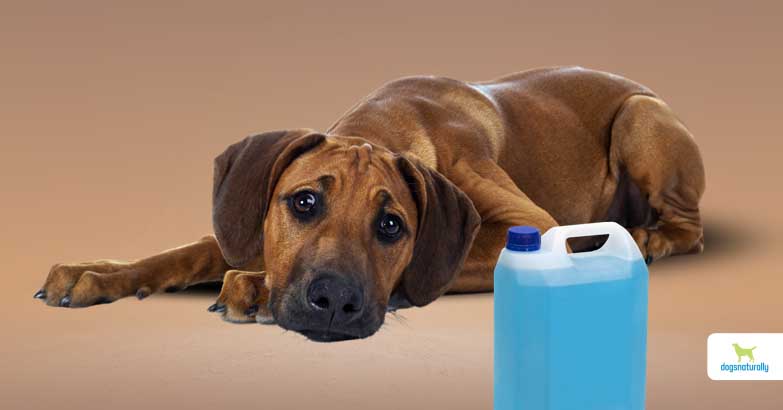With winter comes cold weather, and that means extra antifreeze in the car radiator. It’s the best way to protect your engine from extreme weather … but this toxic liquid is very dangerous for your dog if he gets into it.
What Is Antifreeze Poisoning?
Antifreeze poisoning is a serious risk if your dog drinks antifreeze. Antifreeze is a commonly used coolant that helps regulate engine heat. It’s used year-round, but most people use more of it in the winter. The main ingredient in antifreeze is ethylene glycol. The body breaks ethylene glycol down into toxic metabolites within hours. These toxins can cause severe, acute kidney failure and lead to calcium oxalate crystals in the kidneys as well. So your dog could quickly be poisoned if he drinks even a small amount of antifreeze. And because of the sweet taste of antifreeze, animals are often drawn to it.
What Products Contain Antifreeze?
Antifreeze isn’t just your car’s radiator coolant, though that’s the most likely source. But ethylene glycol can also be in windshield deicer, hydraulic brake fluid, transmission fluid, motor oil, photo developing solutions, solvents, solar water heaters, wood stainers, and paints. Bases of freestanding basketball hoops can also contain antifreeze. And in very cold climates people may even put antifreeze into cabin toilets to stop them freezing in winter … so if you do that be sure to keep the lid down to stop your dog from sneaking a cool drink.
There may also be small amounts of antifreeze in snow globes, so be careful around the holidays and clean up fast if you ever break one.
Pets can get into anything you mistakenly leave lying around. Antifreeze smells and tastes deliciously sweet to them, so your dog is likely to lick it up if he finds it. Just a few licks are a toxic dose that can cause irreversible kidney and liver damage and be fatal for dogs (and cats).
What Are The Symptoms of Antifreeze Poisoning In Dogs?
The signs of antifreeze poisoning in your dog depend on how long ago he drank it. There are three stages of ethylene glycol poisoning, each with different signs.
Stage 1 signs show up within 30 minutes to 12 hours of drinking antifreeze. The most common signs are similar to alcohol intoxication, including …
- Staggering or uncoordinated movement (as if drunk)
- Drooling
- Vomiting
- Seizures
- Frequent urination
- Extreme thirst
Stage 2 signs happen 12-24 hours after drinking antifreeze. At this stage, signs of poisoning may seem to ease. Signs of drunkenness may improve, but you might see different symptoms like …
- Rapid heart rate
- Difficulty breathing
- Dehydration
PRO TIP
To test for dehydration, pinch the loose skin on your dog’s neck. If it pops back to position quickly, he’s fine. If the skin “sticks” for a few moments, he’s dehydrated.
Stage 3 symptoms in dogs appear 36-72 hours after getting into antifreeze. During this stage, your dog can start to develop severe kidney failure. You may see signs like …
- Severe lethargy
- Coma
- Depression
- Vomiting
- Seizures
- Drooling
- Lack of appetite
So, you can see that in stage 2, your dog may seem to feel better. But don’t be fooled …. because after that, he can deteriorate fast. Kidney failure can occur within days. Once that happens, it may be too late to treat him. Signs of kidney failure in dogs are vomiting, unusually low amounts of urine, and depression.
So … if you think your dog has drunk antifreeze, you need to act quickly.
RELATED: How to recognize dog poisoning symptoms …
What Should I Do If My Dog Drinks Antifreeze?
If you see any of the above symptoms or you believe your dog may have drunk antifreeze, you need to get him to the emergency vet. As little as a few tablespoons of antifreeze could be enough to kill a medium-sized dog.
If you saw how much your dog drank, tell the vet. Even if you don’t know how much antifreeze he had, be sure to tell the vet you think it’s antifreeze poisoning. Let the vet know when the symptoms started. Your dog has the best chance of survival if he starts treatment within 8 hours of drinking the antifreeze.
Should I Induce Vomiting if My Dog Drank Antifreeze?
It’s always best to ask your veterinarian or a pet poison helpline before inducing vomiting. Induced vomiting can be risky in some cases because toxic substances can damage the esophagus. If you can’t reach your vet and you’re 100% certain your dog drank antifreeze in the past two hours. you can try to induce vomiting. Don’t do this if your dog has already vomited.
How To Induce Vomiting In Dogs
To induce vomiting, give one teaspoon of hydrogen peroxide to your dog for every 5 pounds of body weight, up to a maximum of three teaspoons per dose. Give up to 3 doses, waiting 10 minutes between each one. If he hasn’t vomited after the third dose, stop giving the solution. Whether your dog vomits or not, your best chance to save him is to get to the vet as quickly as possible so they can treat him for antifreeze poisoning.
PRO TIP
If it’s hard to get your dog to take the liquid from a teaspoon, use a syringe to get it in his mouth.
RELATED: Learn about another deadly type of poison, blue-green algae …
How Do Vets Treat Antifreeze Poisoning?
First, diagnosis can be difficult because signs of antifreeze (aka ethylene glycol) poisoning are similar to symptoms of other central nervous system disease or trauma. Your veterinarian will likely ask about your dog’s medical history, then confirm antifreeze poisoning by testing samples of your dog’s stool or vomit, as well as urine and blood tests.
Treatment For Antifreeze Poisoning
Depending on how long it’s been since your dog drank antifreeze, treatment may involve …
- Induced vomiting
- Flushing the stomach (gastric lavage)
- Activated charcoal (to stop your dog’s body absorbing any more of the fluid)
If it’s been long enough that your dog’s already absorbed the antifreeze, your vet may give excess fluids to force his body to excrete the poison. There is an antidote to antifreeze (called fomepizole), but it must be given within 8-12 hours after drinking antifreeze … before your dog’s kidney function is damaged.
If your dog goes into kidney failure, he could need dialysis (which not all clinics can do). Dialysis removes waste products to give the kidneys a chance to repair. Occasionally, dogs have received kidney transplants.
RELATED: Natural options for kidney disease …
7 Tips To Prevent Antifreeze Poisoning
Now that you’ve seen how deadly antifreeze poisoning can be, here are 7 ways to reduce the risk of this happening to your dog.
- Buy antifreeze made with propylene glycol instead of ethylene glycol. Although propylene glycol is also harmful, it is not as lethal for dogs, and it doesn’t taste as sweet.
- Make sure there are no antifreeze spills or leaks and wipe any drips off the bottles.
- Keep all antifreeze containers tightly sealed and out of your dog’s reach. If possible, keep them in a locked cabinet or closed container.
- Dispose of empty containers properly so no animals can get access to antifreeze.
- Inspect your car radiator regularly and have any leaks repaired right away. If you accidentally spill antifreeze or notice radiator fluid leaking from your car, wipe it up immediately, then spread something absorbent like sawdust or cat litter to stop your dog from lickiny any traces on the floor. Make sure there’s nothing left to be licked up.
- Keep an eye on wandering and curious pets – and keep in mind the other household items that contain antifreeze (described earlier). Don’t let your dog sniff around garages or driveways where there may be antifreeze drips.
- If your dog drinks antifreeze, it’s vital you act immediately to ensure your furry friend’s survival. Take your dog to the vet right away.
Note: cats and other animals can also get into antifreeze, so make sure you monitor all your pets. In cats, kidney failure can develop even faster than in dogs.
RELATED: When your dog needs the emergency vet …
Now you know that just a small amount of antifreeze could prove to be a lethal dose or cause irreparable kidney damage to your dog. So, take precautions to make sure your dog doesn’t come into contact with antifreeze. If he does manage to get into the antifreeze somehow, seek immediate veterinary attention. Delayed treatment could prove fatal.












